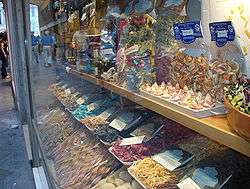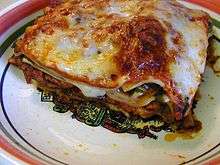Pasta
|
Different types of pasta on display in a shop window in Venice, Italy | |
| Place of origin | Italy |
|---|---|
| Main ingredients | Durum wheat flour |
|
| |
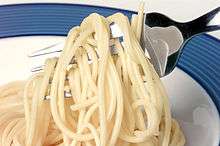
Pasta (Italian pronunciation: [ˈpasta]) is a staple food[1] of traditional Italian cuisine, with the first reference dating to 1154 in Sicily.[2] It is also commonly used to refer to the variety of pasta dishes. Typically, pasta is a noodle made from an unleavened dough of a durum wheat flour mixed with water or eggs and formed into sheets or various shapes, then cooked by boiling or baking. It can also be made with flour from other cereals or grains. Pastas may be divided into two broad categories, dried (pasta secca) and fresh (pasta fresca).
Most dried pasta is commercially produced via an extrusion process although it can be produced in most homes. Fresh pasta was traditionally produced by hand, sometimes with the aid of simple machines,[3] but today many varieties of fresh pasta are also commercially produced by large-scale machines, and the products are widely available in supermarkets.
Both dried and fresh pasta come in a number of shapes and varieties, with 310 specific forms known variably by over 1300 names having been documented.[4] In Italy the names of specific pasta shapes or types often vary with locale. For example, the form cavatelli is known by 28 different names depending on region and town. Common forms of pasta include long shapes, short shapes, tubes, flat shapes and sheets, miniature soup shapes, filled or stuffed, and specialty or decorative shapes.[5]
As a category in Italian cuisine, both fresh and dried pastas are classically used in one of three kinds of prepared dishes. As pasta asciutta (or pastasciutta) cooked pasta is plated and served with a complementary sauce or condiment. A second classification of pasta dishes is pasta in brodo in which the pasta is part of a soup-type dish. A third category is pasta al forno in which the pasta incorporated into a dish that is subsequently baked.[6]
Pasta is generally a simple dish, but comes in many varieties due to its versatility. Some pasta dishes are served as a first course in Italy because the portion sizes are small and simple. Pasta is also prepared in light lunches, such as salads or large portion sizes for dinner. It can be prepared by hand or food processor and served hot or cold. Pasta sauces vary in taste, color and texture. When choosing which type of pasta and sauce to serve together, there is a general rule regarding compatibility. Simple sauces like pesto are ideal for long and thin strands of pasta while tomato sauce combines well with thicker pastas. Thicker and chunkier sauces have the better ability to cling onto the holes and cuts of short, tubular, twisted pastas. The extra sauce left on the plate after all of the pasta is eaten is often mopped up with a piece of bread.[7]
Etymology
First attested in English in 1874, the word pasta comes from Italian pasta, in turn from Latin pasta "dough, pastry cake", itself the latinisation of the Greek παστά (pasta) "barley porridge".
History

In the 1st century AD writings of Horace, lagana (singular: laganum) were fine sheets of fried dough[9] and were an everyday foodstuff.[10] Writing in the 2nd century Athenaeus of Naucratis provides a recipe for lagana which he attributes to the 1st century Chrysippus of Tyana: sheets of dough made of wheat flour and the juice of crushed lettuce, then flavoured with spices and deep-fried in oil.[10] An early 5th century cookbook describes a dish called lagana that consisted of layers of dough with meat stuffing, a possible ancestor of modern-day lasagna.[10] However, the method of cooking these sheets of dough does not correspond to our modern definition of either a fresh or dry pasta product, which only had similar basic ingredients and perhaps the shape.[10] The first concrete information concerning pasta products in Italy dates from the 13th or 14th century.[11]
Historians have noted several lexical milestones relevant to pasta, none of which changes these basic characteristics. For example, the works of the 2nd century AD Greek physician Galen mention itrion, homogeneous compounds made of flour and water.[12] The Jerusalem Talmud records that itrium, a kind of boiled dough,[12] was common in Palestine from the 3rd to 5th centuries AD,[13] A dictionary compiled by the 9th century Arab physician and lexicographer Isho bar Ali[14] defines itriyya, the Arabic cognate, as string-like shapes made of semolina and dried before cooking. The geographical text of Muhammad al-Idrisi, compiled for the Norman King of Sicily Roger II in 1154 mentions itriyya manufactured and exported from Norman Sicily:
West of Termini there is a delightful settlement called Trabia.[15] Its ever-flowing streams propel a number of mills. Here there are huge buildings in the countryside where they make vast quantities of itriyya which is exported everywhere: to Calabria, to Muslim and Christian countries. Very many shiploads are sent.[16]
Itriyya gives rise to trie in Italian, signifying long strips such as tagliatelle and trenette. One form of itriyya with a long history is laganum (plural lagana), which in Latin refers to a thin sheet of dough,[10] and gives rise to Italian lasagna.
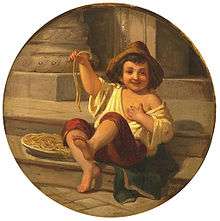
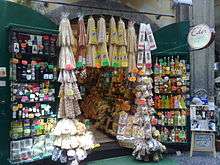
According to historians like Charles Perry, the Arabs adapted noodles for long journeys in the 5th century, the first written record of dry pasta. The dried pasta introduced was being produced in great quantities in Palermo at that time.
In North Africa, a food similar to pasta, known as couscous, has been eaten for centuries. However, it lacks the distinguishing malleable nature of pasta, couscous being more akin to droplets of dough. At first, dry pasta was a luxury item in Italy because of high labor costs; durum wheat semolina had to be kneaded for a long time.
There is a legend of Marco Polo importing pasta from China[17] which originated with the Macaroni Journal, published by an association of food industries with the goal of promoting pasta in the United States.[18] Rustichello da Pisa writes in his Travels that Marco Polo described a food similar to "lagana". Jeffrey Steingarten asserts that Arabs introduced pasta in the Emirate of Sicily in the ninth century, mentioning also that traces of pasta have been found in ancient Greece and that Jane Grigson believed the Marco Polo story to have originated in the 1920s or 30s in an advertisement for a Canadian spaghetti company.[19]
In Greek mythology, it is believed that the god Hephaestus invented a device that made strings of dough. This was the earliest reference to a pasta maker.
In the 14th and 15th centuries, dried pasta became popular for its easy storage. This allowed people to store pasta on ships when exploring the New World.[20] A century later, pasta was present around the globe during the voyages of discovery.[21]
The invention of the first tomato sauces dates from the late 18th century: the first written record of pasta with tomato sauce can be found in the 1790 cookbook L'Apicio Moderno by Roman chef Francesco Leonardi.[22] Before tomato sauce was introduced, pasta was eaten dry with the fingers; the liquid sauce demanded the use of a fork.[20]
History of manufacturing
Pasta manufacturing machines were made since the 1600s across the coast of Sanremo. The extrusion press produced large amounts of uniform pastas. The consistency of shapes and texture of the pasta manufactured by the extrusion press is believed to be superior to handmade pasta. This technology spread to other areas including Genoa, Apulia, Brindisi, Bari, and Tuscany. By 1867, Buitoni Company in Sansepolcro, Tuscany in the upper Tiber Valley became one of the most successful and well-known pasta manufacturers in the world.[23]
Evolution
It is to be noted that the idea of using tomato sauce to give pasta its flavour was revolutionary since it was originally eaten plain. The consumption of pasta has changed over time; it was once a small, simple item, but it is now often eaten in much larger portions and as part of complex, sophisticated dishes. Factors such as low prices and ease of cooking contribute to the growing popularity of this staple item.[24]
In modern times
The art of pasta making and the devotion to the food as a whole has evolved since pasta was first conceptualized. “It is estimated that Italians eat over sixty pounds of pasta per person, per year, easily beating Americans, who eat about twenty pounds per person.”[25] Pasta is so beloved in the nation of Italy that individual consumption exceeds the average production of wheat of the country; thus Italy frequently imports wheat for pasta making. In contemporary society pasta is ubiquitous, and individuals can find a variety of types in local supermarkets. With the worldwide demand for this staple food, pasta is now largely mass-produced in factories and only a tiny proportion is crafted by hand. However, while pasta is made everywhere, “the product from Italy keeps to time-tested production methods that create a superior pasta”.[25]
Pasta was originally solely a part of Italian and European cuisine owing to its popularity there. With an increase in popularity on a world-wide scale, pasta has crossed international borders and is now a popular form of fast food and a staple in North America and elsewhere. This is due to the great amount of Italian immigration into Canada and the United States around the beginning of the 20th century. Similarly an immense immigration of Italians into South Africa ensured that spaghetti with meatballs became an essential part of South African cuisine.[26]
Ingredients
Since the time of Cato, basic pasta dough has been made mostly of wheat flour or semolina,[4] with durum wheat used predominantly in the South of Italy and soft wheat in the North. Regionally other grains have been used, including those from barley, buckwheat, rye, rice, and maize, as well as chestnut and chickpea flours.
To address needs of people affected by gluten-related disorders (such as coeliac disease, non-celiac gluten sensitivity and wheat allergy sufferers),[27] some recipes use rice or maize for making pasta. Grain flours may also be supplemented with cooked potatoes.[28][29]
Other additions to the basic flour-liquid mixture may include vegetable purees such as spinach or tomato, mushrooms, cheeses, herbs, spices and other seasonings. While pastas are, most typically, made from unleavened doughs, the use of yeast-raised doughs are also known for at least nine different pasta forms.[4]
Varieties
-
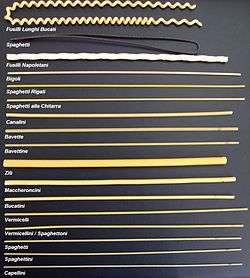
Long pasta
-

Short pasta
-
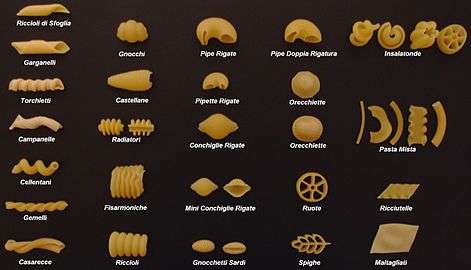
Short pasta
-
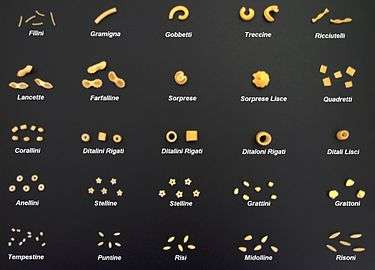
Minute pasta (pastina, used for soups)
-
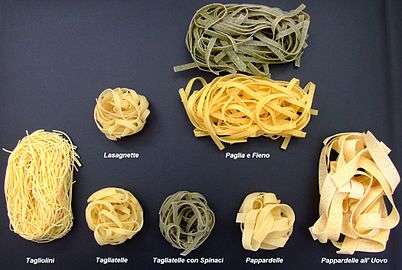
Pasta all'uovo (egg pasta)
-
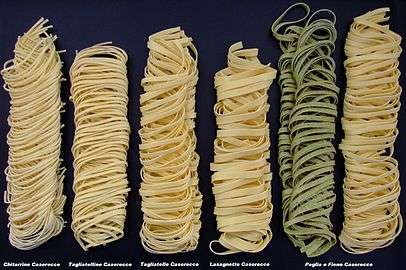
Fresh pasta
-
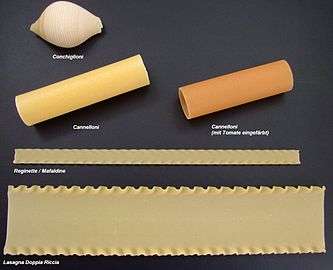
Pasta for pasta al forno (baked pasta) dishes
Fresh
Fresh pasta is usually locally made with fresh ingredients unless it is destined to be shipped, in which case consideration is given to the spoilage rates of the desired ingredients such as eggs or herbs. Furthermore, fresh pasta is usually made with a mixture of eggs and all-purpose flour or “00” low-gluten flour. Since it contains eggs, it is more tender compared to dried pasta and only takes about half the time to cook.[30] Delicate sauces are preferred for fresh pasta in order to let the pasta take front stage.[31]
Fresh pastas do not expand in size after cooking; therefore, one and one-half pounds of pasta are needed to serve four people generously.[30] Fresh egg pasta is generally cut into strands of various widths and thicknesses depending on which pasta is to be made (e.g. fettuccine, pappardelle, and lasagne). It is best served with meat, cheese, or vegetables to create ravioli, tortellini, and cannelloni. Fresh egg pasta is well known in the Piedmont area near the border of France. In this area, dough is only made out of egg yolk and flour resulting in a very refined flavour and texture. This pasta is often served simply with butter sauce and thinly sliced truffles that are native to this region. In other areas, such as Apulia fresh pasta can be made without eggs. The only ingredients needed to make the pasta dough are semolina flour and water, which is often shaped into orecchiette or cavatelli. Fresh pasta for cavatelli is also popular in other places including Sicily. However, the dough is prepared differently: it is made of flour and ricotta cheese instead.[32]
Dried
Dried pasta can also be defined as factory-made pasta because it is usually produced in large amounts that require large machines with superior processing capabilities to manufacture.[32] Dried pasta is mainly shipped over to farther locations and has a longer shelf life. The ingredients required to make dried pasta include semolina flour and water. Eggs can be added for flavour and richness, but are not needed to make dried pasta. In contrast to fresh pasta, dried pasta needs to be dried at a low temperature for several days to evaporate all the moisture allowing it to be stored for a longer period. Dried pastas are best served in hearty dishes like ragu sauces, soups, and casseroles.[31] Once it is cooked, the dried pasta will usually increase in size by double of its original proportion. Therefore, approximately one pound of dried pasta serves up to four people.[30]
Culinary uses

Pasta is generally served with some type of sauce; the sauce and the type of pasta are usually matched based on consistency and ease of eating. Northern Italian cooking uses less tomato sauce, garlic and herbs. In Northern Italy white sauce is more common.[33] However Italian cuisine is best identified by individual regions. Pasta dishes with lighter use of tomato are found in Trentino-Alto Adige and Emilia Romagna.[34][35] In Bologna, the meat-based Bolognese sauce incorporates a small amount of tomato concentrate and a green sauce called pesto originates from Genoa. In Central Italy, there are sauces such as tomato sauce, amatriciana, arrabbiata and the egg-based carbonara. Tomato sauces are also present in Southern Italian cuisine, where they originated. In Southern Italy more complex variations include pasta paired with fresh vegetables, olives, capers or seafood. Varieties include puttanesca, pasta alla norma (tomatoes, eggplant and fresh or baked cheese), pasta con le sarde (fresh sardines, pine nuts, fennel and olive oil), spaghetti aglio, olio e peperoncino (literally with garlic, [olive] oil and hot chili peppers).
Production
Pasta made fresh

Ingredients to make pasta dough include semolina flour, egg, salt and water. Flour is first mounded on a flat surface and then a well in the pile of flour is created. Egg is then poured into the well and a fork is used to mix the egg and flour.[36] There are a variety of ways to shape the sheets of pasta depending on the type required. The most popular types include penne, spaghetti, and macaroni.[37]
Kitchen pasta machines, also called pasta makers, are popular with cooks who make large amounts of fresh pasta. The cook feeds sheets of pasta dough into the machine by hand, and by turning a hand crank, extrudes the pasta through a machine 'comb' that shapes the pasta noodles as they are extruded.
Storage
The storage of pasta depends on how far along it is processed. Uncooked pasta is kept dry and can sit in the cupboard for a year if airtight and stored in a cool, dry area. Cooked pasta is stored in the refrigerator for a maximum of five days in an airtight container. Adding a couple teaspoons of oil helps keep the food from sticking to each other and the container. If the cooked pasta is not used in the five days it may be frozen for up to two or three months. The pasta will start to dry after a period of time, but it varies with the type of pasta. Should the pasta be dried completely, it can be placed back in the cupboard.[38]
Processing
Semolina flour consists of a protein matrix with entrapped starch granules. Upon the addition of water, during mixing, intermolecular forces allow the protein to form a more ordered structure in preparation for cooking.[39]
Factory-manufactured
The ingredients to make dried pasta usually include water and semolina flour; egg for colour and richness (in some types of pasta), and possibly vegetable juice (such as spinach, beet, tomato, carrot), herbs or spices for colour and flavour. After mixing semolina flour with warm water the dough is kneaded mechanically until it becomes firm and dry. If pasta is to be flavoured, eggs, vegetable juices, and herbs are added at this stage. The dough is then passed into the laminator to be flattened into sheets, then compressed by a vacuum mixer-machine to clear out air bubbles and excess water from the dough until the moisture content is reduced to 12%. Next, the dough is processed in a steamer to kill any bacteria it may contain.
The dough is then ready to be shaped into different types of pasta. Depending on the type of pasta to be made, the dough can either be cut or extruded through dies. The pasta is set in a drying tank under specific conditions of heat, moisture, and time depending on the type of pasta. The dried pasta is then packaged: Fresh pasta is sealed in a clear, airtight plastic container with a mixture of carbon dioxide and nitrogen that inhibits microbial growth and prolongs the product's shelf life; Dried pastas are sealed in clear plastic or cardboard packages.[40]
Market
Italy produced 1,432,990 tons of spaghetti in 1955, of which 74,000 tons was exported, and had a production capacity of 3 million tons.[41] By 2011, the three largest producers of dried pasta were Italy (3,247,322 tonnes), the United States (3,000,000 tonnes), and Brazil (1,300,000 tonnes).[42] The largest per capita consumers of pasta in 2011 were Italy (26.0 kg/person), Venezuela (12.0 kg/person), Tunisia (11.7 kg/person), and Greece (10.4 kg/person).
In the European Union, total pasta sales in 2008 were US $8.361 billion, of which $5.722 billion was for dried pasta, $2.244 billion was for fresh or chilled pasta, and $395 million was for canned or preserved pasta.[43] In 2009, retail sales of pasta represented a $2.809 billion market in Italy, $1.402 billion in Germany, and $1.179 billion in France.[43] Fresh pasta represented a $996 million market in Italy in 2008.[43]
Italy is the world's largest exporter of pasta; in 2007, it exported 1.7 million tons of pasta, and the largest export markets were Germany (20.4%), France (13.7%), the United Kingdom (12.6%), the United States (9.5%), and Japan (4.25%). Italy's pasta exports represented 53% of its total production in 2007.[44]
Nutrition
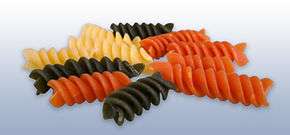
Pasta is mostly starch because it is made of flour. It also contains other minerals and vitamins either directly from wheat or from artificial enrichment. Whole wheat pasta contains considerable amounts of minerals such as magnesium, iron, calcium, potassium, zinc, selenium and manganese.[45] This type of pasta is known to be healthier as it contains more nutrients than white pasta. During the refining stages, the nutrients are forced out, leaving behind mostly starch and flour. Many diets will actually recommend whole wheat pasta as it is a healthy source of carbohydrates, similar to brown rice. Pasta also contains a small amount of sodium, and if made without eggs has no cholesterol. Pastas also contains vitamin B, which includes folic acid and niacin.[46]
The amount of protein in pasta depends on the type of flour used to manufacture it. If it is made from durum wheat, the pasta contains protein and gluten. Pasta contains protein comprising six of the nine essential amino acids.[47][48] If the pasta is made with eggs, it contains more protein since eggs contain 6 grams of protein and pasta only contains 2.9 grams.
International adaptations
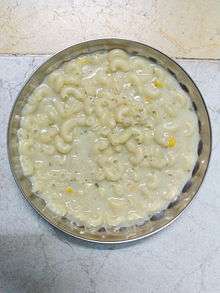
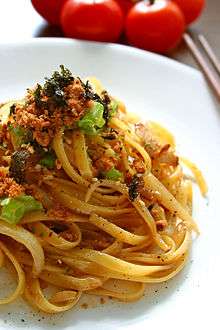
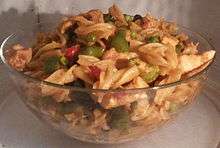
As pasta was introduced elsewhere in the world, it became incorporated into a number of local cuisines, which often have significantly different ways of preparation from those of Italy. In Hong Kong, the local Chinese have adopted pasta, primarily spaghetti and macaroni, as an ingredient in the Hong Kong-style Western cuisine.
When pasta was introduced to several nations, every culture adopted different style of preparing it. In the past, ancient Romans cooked pastas by frying or boiling it. It was also sweetened with honey or tossed with garum. Ancient Romans also enjoyed baking it in rich pies, called timballi.[49]
In Cha chaan teng (茶餐廳), macaroni is cooked in water and served in broth with ham or frankfurter sausages, peas, black mushrooms, and optionally eggs, reminiscent of noodle soup dishes. This is often a course for breakfast or light lunch fare.[50] These affordable dining shops evolved from American food rations after World War II due to lack of supplies, and they continue to be popular for people with modest means.
Two common spaghetti dishes served in Japan are the Bolognese (ミートソース) and the Napolitan (ナポリタン). In Nepal, macaroni has been adopted and cooked in a Nepalese way. Boiled macaroni is sautéed along with cumin, turmeric, finely chopped green chillies, onions and cabbage. In Greece hilopittes is considered one of the finest types of dried egg pasta. It is cooked either in tomato sauce or with various kinds of casserole meat. It is usually served with Greek cheese of any type.
Pasta is also widespread in the Southern Cone, as well most of the rest of Brazil, mostly pervasive in the areas with mild to strong Italian roots, such as Central Argentina, and the eight southernmost Brazilian states (where macaroni are called macarrão, and more general pasta is under the umbrella term massa, literally "dough", together with some Japanese noodles, such as bifum rice vermicelli and yakisoba, which also entered general taste). The local names for the pasta are many times varieties of the Italian names, such as ñoquis/nhoque for gnocchi, ravioles/ravióli for ravioli, or tallarines/talharim for tagliatelle, although some of the most popular pasta in Brazil, such as the parafuso ("screw", "bolt"), a specialty of the country's pasta salads, are also way different both in name and format from its closest Italian relatives, in this case the fusilli.[51]
In Sweden, spaghetti is traditionally served with köttfärssås (Bolognese sauce), which is minced meat in a thick tomato soup.
In the Philippines, spaghetti is often served with a distinct, slightly sweet yet flavourful meat sauce (the base of which would be tomato sauce or paste and ketchup), frequently containing ground beef or pork and diced hot dogs and ham. It is spiced with some soy sauce, heavy quantities of garlic, dried oregano sprigs and sometimes with dried bay leaf, and afterwards topped with grated cheese. Other pasta dishes are also cooked nowadays in the Filipino kitchen, like carbonara, pasta with alfredo sauce, and baked macaroni. These dishes are usually cooked for gatherings and special occasions, like family reunions or Christmas. Macaroni or other tube pasta is also used in sopas, a local chicken broth soup.
Fettuccine alfredo with cream, cheese and butter, and spaghetti with tomato sauce (with or without meat) are popular Italian-style dishes in the United States.
In Australia, boscaiola sauce, based on bacon and mushrooms, is one favorite among many.
Regulations
Italy
Although numerous variations of ingredients for different pasta products are known, in Italy the commercial manufacturing and labeling of pasta for sale as a food product within the country is highly regulated.[52][53] Italian regulations recognise three categories of commercially manufactured dried pasta as well as manufactured fresh and stabilized pasta:
Pasta: Dried pasta with three subcategories – (i.) Durum wheat semolina pasta (pasta di semola di grano duro), (ii.) Low grade durum wheat semolina pasta (pasta di semolato di grano duro) and (iii.) Durum wheat whole meal pasta (pasta di semola integrale di grano duro). Pastas made under this category must be made only with durum wheat semolina or durum wheat whole-meal semolina and water, with an allowance for up to 3% of soft-wheat flour as part of the durum flour. Dried pastas made under this category must be labeled according to the subcategory.
Special pastas (paste speciali): As Pasta above, with additional ingredients other than flour and water or eggs. Special pastas must be labeled as durum wheat semolina pasta on the packaging completed by mentioning the added ingredients used (e.g., spinach). The 3% soft flour limitation still applies.
Egg pasta (pasta all'uovo): May only be manufactured using durum wheat semolina with at least 4 hens’ eggs (chicken) weighing at least 200 grams (without the shells) per kilogram of semolina, or a liquid egg product produced only with hen’s eggs. Pasta made and sold in Italy under this category must be labeled egg pasta.
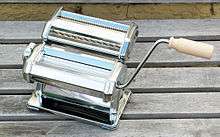
Fresh and stabilized pastas (paste alimentari fresche e stabilizzate): Includes fresh and stabilized pastas, which may be made with soft-wheat flour without restriction on the amount. Prepackaged fresh pasta must have a water content not less than 24%, must be stored refrigerated at a temperature of not more than 4 °C (with a 2 °C tolerance), must have undergone a heat treatment at least equivalent to pasteurisation, and must be sold within 5 days of the date of manufacture. Stabilized pasta has a lower allowed water content of 20%, and is manufactured using a process and heat treatment that allows it to be transported and stored at ambient temperatures.
The Italian regulations under Presidential Decree N° 187 apply only to the commercial manufacturing of pastas both made and sold within Italy. They are not applicable either to pasta made for export from Italy or to pastas imported into Italy from other countries. They also do not apply to pastas made in restaurants.
United States
In the United States, regulations for commercial pasta products occur both at the Federal and State levels. At the Federal level, consistent with Section 341 of the Federal Food, Drug, and Cosmetic Act,[54] the Food and Drug Administration (FDA) has defined standards of identity for what are broadly termed macaroni products. These standards appear in 21 CFR Part 139.[55] In those regulations the requirements for standardized macaroni products of 15 specific types of dried pastas are detailed, including ingredients and product specific labeling for conforming products sold in the U.S., including imports:
Macaroni products – is defined as the class of food prepared by drying formed units of dough made from semolina, durum flour, farina, flour, or any combination of those ingredients with water. Within this category various optional ingredients may also be used within specified ranges, including egg white, frozen egg white or dried egg white alone or in any combination; disodium phosphate; onions, celery, garlic or bay leaf, alone or in any combination; salt; gum gluten; and concentrated glyceryl monostearate. Specific dimensions are given for the shapes named macaroni, spaghetti and vermicelli.
Enriched macaroni products – is largely the same as macaroni products except that each such food must contain thiamin, riboflavin, niacin or niacinamide, folic acid and iron, with specified limits. Additional optional ingredients that may be added include vitamin D, calcium, and defatted wheat germ. The optional ingredients specified may be supplied through the use of dried yeast, dried torula yeast, partly defatted wheat germ, enriched farina, or enriched flour.
Enriched macaroni products with fortified protein–similar to enriched macaroni products with the addition of other ingredients to meet specific protein requirements. Edible protein sources that may be used include food grade flours or meals from nonwheat cereals or oilseeds. Products in this category must include specified amounts of thiamin, riboflavin, niacin or niacinamide and iron, but not folic acid. The products in this category may also optionally contain up to 625 milligrams of calcium.
Milk macaroni products – the same as macaroni products except that milk or a specified milk product is used as the sole moistening ingredient in preparing the dough. Other than milk, allowed milk products include concentrated milk, evaporated milk, dried milk, and a mixture of butter with skim, concentrated skim, evaporated skim, or nonfat dry milk, in any combination, with the limitation on the amount of milk solids relative to amount of milk fat.
Nonfat milk macaroni products – the same as macaroni products except that nonfat dry milk or concentrated skim milk is used in preparing the dough. The finished macaroni product must contain between 12% and 25% milk solids-not-fat. Carageenan or carageenan salts may be added in specified amounts. The use of egg whites, disodium phosphate and gum gluten optionally allowed for macaroni products is not permitted for this category.
Enriched nonfat milk macaroni products – similar to nonfat milk macaroni products with added requirements that products in this category contain thiamin, riboflavin, niacin or niacinamide, folic acid and iron, all within specified ranges.
Vegetable macaroni products – begins as macaroni products except that tomato (of any red variety), artichoke, beet, carrot, parsley or spinach is added in a quantity such that the solids of the added component are at least 3% by weight of the finished macaroni product. The vegetable additions may be in the form of fresh, canned, dried or a puree or paste. The addition of either the various forms of egg whites or disodium phosphate allowed for macaroni products is not permitted in this category.
Enriched vegetable macaroni products – the same as vegetable macaroni products with the added requirement for nutrient content specified for enriched macaroni products.
Whole wheat macaroni products – similar to macaroni products except that only whole wheat flour or whole wheat durum flour, or both, may be used as the wheat ingredient. Further the addition of the various forms of egg whites, disodium phosphate and gum gluten are not permitted.
Wheat and soy macaroni products – begins as macaroni products with the addition of at least 12.5% of soy flour as a fraction of the total soy and wheat flour used. The addition the various forms of egg whites and disodium phosphate are not permitted. Gum gluten may be added with a limitation that the total protein content derived from the combination of the flours and added gluten not exceed 13%.
Noodle products – are the class of food that is prepared by drying units of dough made from semolina, durum flour, farina, flour, alone or in any combination with liquid eggs, frozen eggs, dried eggs, egg yolks, frozen yolks, dried yolks, alone or in any combination, with or without water. Optional ingredients that may be added in allowed amounts are onions, celery, garlic, and bay leaf; salt; gum gluten; and concentrated glyceryl monostearate.
Enriched noodle products – similar to noodle products with the addition of specific requirements for amounts of thiamin, riboflavin, niacin or niacinamide, folic acid and iron, each within specified ranges. Additionally products in this category may optionally contain added vitamin D, calcium or defatted wheat germ, each within specified limits.
Vegetable noodle products – the same as noodle products with the addition of tomato (of any red variety), artichoke, beet, carrot, parsley, or spinach in an amount that is at least 3% of the finished product weight. The vegetable component may be added as fresh, canned, dried, or in the form of a puree or paste.
Enriched vegetable noodle products – the same as vegetable noodle products excluding carrot, with the specified nutrient requirements for enriched noodle products.
Wheat and soy noodle products – similar to noodle products except that soy flour is added in a quantity not less than 12.5% of the combined weight of the wheat and soy ingredients.
It is important to note that the federal regulations under 21 CFR Part 139 are standards for the products noted, not mandates. Following the FDA’s standards, a number of states have, at various times, enacted their own statutes that serve as mandates for various forms of macaroni and noodle products that may be produced or sold within their borders. Many of these specifically require that the products sold within those states be of the enriched form.[56][57][58][59] According to a report released by the Connecticut Office of Legislative Research, when Connecticut’s law was adopted in 1972 that mandated certain grain products, including macaroni products, sold within the state to be enriched it joined 38 to 40 other states in adopting the federal standards as mandates.[60]
Beyond the FDA’s standards and state statutes the United States Department of Agriculture (USDA), which regulates federal school nutrition programs,[61][62] broadly requires grain and bread products served under these programs either be enriched or whole grain (see 7 CFR 210.10 (k) (5)). This includes macaroni and noodle products that are served as part the category grains/breads requirements within those programs. The USDA also allows that enriched macaroni products fortified with protein may be used and counted to meet either a gains/breads or meat/alternative meat requirement, but not as both components within the same meal.[63]
Pasta in art
Commonly referred to as macaroni art, dry pasta (often noodles) may consist of individual pieces of macaroni glued to a surface to produce a mosaic, or may take the form of sculptures.
See also
Notes
- ↑ Ehrlich, Richard (6 May 2009). "Process of Elimination". The Guardian. Retrieved 7 July 2012.
- ↑ McClatchey, Caroline (15 June 2011). "How pasta became the world's favourite food". BBC. Retrieved 23 March 2012.
- ↑ Hazan, Marcella (1992) Essentials of Classic Italian Cooking, Knopf, ISBN 0-394-58404-X
- 1 2 3 Zanini De Vita, Oretta, Encyclopedia of Pasta, University of California Press, ISBN 9780520255227
- ↑ Hazan, Giuliano (1993) The Classic Pasta Cookbook, Dorling Kindersley, ISBN 1564582922
- ↑ "Retrieved 21 March 2012". Italianfood.about.com. 10 April 2012. Retrieved 30 July 2012.
- ↑ Pasta. UK: Parragon Publishing. 2005. pp. 6–57. ISBN 1405425164.
- ↑ Watson, Andrew M (1983). Agricultural innovation in the early Islamic world. New York: Cambridge University Press. p. 22-3
- ↑ Serventi and Sabban, p. 24
- 1 2 3 4 5 Serventi and Sabban, pp. 15–16
- ↑ Serventi and Sabban, p. 10
- 1 2 Serventi and Sabban, p. 17
- ↑ Serventi and Sabban, p. 29
- ↑ "A medical text in Arabic written by a Jewish doctor living in Tunisia in the early 900s", according to Dickie, John (2008). Delizia! The Epic History of Italians and Their Food. New York: Simon and Schuster. pp. 21 ff. ISBN 1416554009.
- ↑ The Sicilian coast east of Palermo is being described.
- ↑ Quoted in Dickie, p. 21.
- ↑ "Who "invented" pasta?". National Pasta Association: "The story that it was Marco Polo who imported noodles to Italy and thereby gave birth to the country's pasta culture is the most pervasive myth in the history of Italian food." (Dickie, p. 48).
- ↑ Serventi and Sabban
- ↑ Jeffrey Steingarten (1998). The Man Who Ate Everything. Knopf Doubleday Publishing Group. p. 260. ISBN 978-0-375-70202-0.
- 1 2 Walker, Margaret E. "The History of Pasta". inmamaskitchen. Archived from the original on 31 March 2012. Retrieved 24 March 2012.
- ↑ Demetri, Justin. "History of pasta". lifeinitaly. Retrieved 24 March 2012.
- ↑ Faccioli, Emilio (1987). L'Arte della cucina in Italia (in Italian). Milan: Einaudi. p. 756. The culí di pomodoro recipe is in the chapter devoted to Leonardi.
- ↑ "The History of Pasta: It's not what you think!". Pasta Recipes by Italians. Retrieved 26 March 2012.
- ↑ "The History of Pasta in the Italian Kitchen". Archived from the original on 24 August 2011. Retrieved 26 March 2012.
- 1 2 Demetri, Justin. "History of Pasta". Retrieved 29 March 2012.
- ↑ Tracey, Michael. "The Origin and History of Pasta where Pasta comes from". Retrieved 28 March 2012.
- ↑ Vriezinga SL, Schweizer JJ, Koning F, Mearin ML (Sep 2015). "Coeliac disease and gluten-related disorders in childhood". Nat Rev Gastroenterol Hepatol (Review). 12 (9): 527–36. doi:10.1038/nrgastro.2015.98. PMID 26100369.
Gluten-related disorders such as coeliac disease, wheat allergy and noncoeliac gluten sensitivity are increasingly being diagnosed in children. (...) These three gluten-related disorders are treated with a gluten-free diet.
- ↑ Ferreira SM, de Mello AP, de Caldas Rosa dos Anjos M, Krüger CC, Azoubel PM, de Oliveira Alves MA (Jan 15, 2016). "Utilization of sorghum, rice, corn flours with potato starch for the preparation of gluten-free pasta". Food Chem. 191: 147–51. doi:10.1016/j.foodchem.2015.04.085. PMID 26258714.
- ↑ Padalino L, Mastromatteo M, Lecce L, Spinelli S, Conte A, Del Nobile MA (Mar 2015). "Optimization and characterization of gluten-free spaghetti enriched with chickpea flour". Int J Food Sci Nutr. 66 (2): 148–58. doi:10.3109/09637486.2014.959897. PMID 25519246.
- 1 2 3 Quessenberry, Sara. "Dried Vs. Fresh Pasta". Real Simple. Retrieved 28 March 2012.
- 1 2 Christensen, Emma. "Dry Pasta vs. Fresh Pasta: What's the Difference?". The Kitchn. Retrieved 28 March 2012.
- 1 2 Laux, Sandra. "Types of Pasta". Mangia Bene Pasta. Retrieved 28 March 2012.
- ↑ Montany, Gail (19 June 2011). "Lidia Bastianich on the quintessential Italian meal". The Aspen Business Journal. Archived from the original on 30 January 2012. Retrieved 1 January 2012.
- ↑ Bastianich, Lidia; Tania, Manuali. Lidia Cooks from the Heart of Italy: A Feast of 175 Regional Recipes (1st ed.).
- ↑ Bastianich, Lidia; John, Mariani. How Italian Food Conquered the World (1st ed.).
- ↑ "How to Make Pasta Dough". allrecipes. Retrieved 24 March 2012.
- ↑ "Fresh Pasta". allrecipes. Retrieved 24 March 2012.
- ↑ Recipe Tips. "Pasta Handling, Safety & Storage". Retrieved 27 March 2012.
- ↑ Sicignano, Angelo; Di Monaco, Rossella; Masi, Paolo; Cavella, Silvana (2015-10-01). "From raw material to dish: pasta quality step by step". Journal of the Science of Food and Agriculture. 95 (13): 2579–2587. doi:10.1002/jsfa.7176. ISSN 1097-0010.
- ↑ "How pasta is made". made how. Retrieved 27 March 2012.
- ↑ Salerno, George (13 December 1956). "Spaghetti consumption up as national dish in Italy". Wilmington Morning Star. 90 (52). Wilmington, North Carolina. United Press.
- ↑ "World Pasta Production". International Pasta Organisation. Archived from the original on 5 September 2012.
- 1 2 3 "Consumer Trends: Pasta Market in the EU27" (PDF). International Markets Bureau, Agriculture and Agri-Food Canada. April 2010. Archived from the original (PDF) on 30 October 2012. Retrieved 30 June 2012.
- ↑ "Italian pasta conquers abroad: Export up by 48% halfway through 2008". Italian Institute for Foreign Trade. Retrieved 30 June 2012.
- ↑ "Spaghetti, whole-wheat, cooked". Retrieved 30 March 2012.
- ↑ Feeney, Mary Jo. "Pasta Nutrition". National Pasta Association. Archived from the original on 15 June 2006. Retrieved 28 March 2012.
- ↑ "Incomplete Pasta Protein?". Retrieved 29 March 2012.
- ↑ "Pasta Nutrition Facts". Retrieved 29 March 2012.
- ↑ "Pasta". eNotes. Retrieved 27 March 2012.
- ↑ Explore the world of Canto-Western cuisine. Associated Press via MSNBC (8 January 2007). Retrieved on 19 September 2013.
- ↑ Tipos de macarrão. Receitas da Fulaninha. receitasdafulaninha.blogspot.com.br. November 2011
- ↑ "Rules for the Review of Legislation on Production of Flour and Pasta". Italian Government Printing Office. Retrieved 7 July 2012.
- ↑ "Rules for the Review of Legislation on Production of Flour and Pasta (English Translation)" (PDF). Union of Organisations of Manufacturers of Pasta Products to the EU. Retrieved 7 July 2012.
- ↑ "Food, Drug, and Cosmetic Act, Title 21, Chapter 9, S. IV, Sec. 341" (PDF). Retrieved 7 July 2012.
- ↑ "U.S. Code of Federal Regulation, Title 21 Part 139". Retrieved 7 July 2012.
- ↑ "State of Connecticut General Provisions, Chapter 417, Sections 21a-28 (Pure Foods and Drugs)". Retrieved 7 July 2012.
- ↑ "State of Florida Statutes, Chapter 500.301–500.306 (Food Products)". Retrieved 7 July 2012.
- ↑ "Utah Administrative Codes – Rule R70-620. Enrichment of Flour and Cereal Products". Retrieved 7 July 2012.
- ↑ "Oregon Revised Statues § 616.785 Sale of unenriched flours, macaroni or noodle products prohibited". Retrieved 7 July 2012.
- ↑ Duffy, Daniel. "Legislative History of Statute Concerning the Regulation of Grain Product". Connecticut General Assembly. Retrieved 7 July 2012.
- ↑ "U.S. Code of Federal Regulation, Title 7, Part 210 – National School Lunch Program". GPO. Retrieved 7 July 2012.
- ↑ "U.S. Code of Federal Regulation, Title 7, Part 220 – National School Breakfast Program". GPO. Retrieved 7 July 2012.
- ↑ "USDA Buying Guide for Child Nutrition Programs – Grains and Bread" (PDF). United States Department of Agriculture. Archived from the original (PDF) on 13 May 2013. Retrieved 7 July 2012.
References
- Serventi, Silvano; Sabban, Francoise (2002). Pasta: The Story of a Universal Food (translated ed.). New York: Columbia University Press. ISBN 978-0-231-12442-3.
External links
| Look up pasta in Wiktionary, the free dictionary. |
- National Museum of Pasta Foods – Rome, Italy
- Pasta Facts – Facts about pasta
